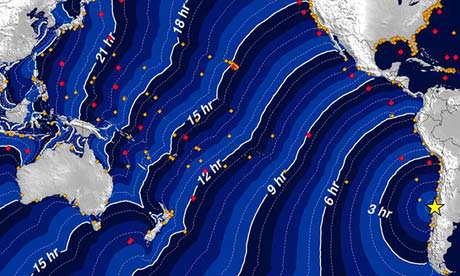[/caption]
While a huge earthquake off the coast of Chile triggered a tsunami that moved at the speed of a jet aircraft across the Pacific Ocean on Feb. 27, the tsunami event – thankfully — was smaller than scientists expected. Some experts forecasted the event would produce 9-foot tall tsunami waves slamming coastlines along the Pacific Rim, which did not materialize; it would have been one of the biggest tsunami on record. At magnitude 8.8, this earthquake was among the largest seismic activity ever recorded. So, why was the resulting tsunami not a “mega event” as well?
“It is too early to know for sure,” said Anne Sheehan, a geologist from the University of Colorado – Boulder.
“It was a truly enormous “megathrust” earthquake, shallow and offshore,” Sheehan told Universe Today. “That kind of earthquake can generate a large tsunami if it displaces a large area of seafloor vertically (either up or down). It could be that more of the earthquake displacement was at depth below the seafloor, and did not rupture the seafloor surface as much as was expected given the size and depth of the earthquake.”
Sheehan said the Chilean earthquake released more than 400 times the energy of the recent Haiti earthquake. “It was truly an enormous earthquake in terms of energy release, the largest in the world since the 2004 Sumatra earthquake and the fifth largest since 1900,” she said.
The earthquake that generated the great Indian Ocean tsunami of 2004 is estimated to have released the energy of 23,000 Hiroshima-type atomic bombs, according to the U.S. Geological Survey (USGS).
The 8.8 quake in Chile released the energy equivalent of 20 billion tons of TNT, or 400 times the largest nuclear weapon ever detonated, the Tsar Bomba, a 50 megaton test done by the USSR in 1961.

Chile is along the “Ring of Fire” that stretches north from South America to the Aleutian Islands, then south through Japan, Indonesia and to New Zealand. The fault zone of the Chilean earthquake was extremely long — several hundred miles — signaling the potential for further large earthquakes in the region.
“These large earthquakes in the Southern Hemisphere have the potential to cause tsunamis all over the Pacific Rim,” Sheehan said in a press release. “Fortunately, people have a much greater understanding of the phenomenon today. Before 2004, a lot of people didn’t even know what a tsunami was,” she said.
Sheehan said she believes that lessons learned by Chilean experts following a world-recording setting magnitude 9.5 quake there in 1960, and subsequent quakes in the next several decades, resulted in stricter building codes, saving many lives. “The death toll is expected to be far smaller than in Haiti, an example showing that mitigation efforts really can be effective.”
As of this writing, the death toll stands of the Chile earthquake stands at 711. The quake in Haiti killed over 200,000 people.

Lessons learned from the 2004 Indian Ocean event also allowed officials to send out effective early warnings and initiate the evacuation of tens of thousands of people living on Pacific islands. Now, even more is being learned about the nature of tsunamis from this latest event, and future predictions should improve.
Sources: Email interview with Anne Sheehan, CU-Boulder press release


There were several reasons why the death toll will be far lower. The Haitian earthquake was very close to the most densely populated part of the country, there was no anticipation of a major quake there since the last one was 250 years ago, and nobody knew how to react in such an event, That part of Haiti is also mostly clays and softer soils which was very prone to “liquefaction” during an earthquake anfd thus amplifying the shaking and the consequent destruction. And of course, there is the sheep poverty of the Haitian nation, and the resulting poor construction of the buildings.
The quake in Chile was offshore and close to a lightly populated area of the country. If it had happened under Santiago, many thousands would have died in spite of the tougher building codes.
I watched some of the tsunami coverage on the Internet — it was truly fascinating and awe-inspiring to see the water rushing out to sea then sweeping back like that, even though (thankfully) the amplitude of the tsunami was only a few feet high.
I have friends who barely escaped the Indian Ocean tsunami with their lives (their hotel room was trashed but they were elsewhere). I’ just glad the same devastation didn’t happen yesterday, but it is a warning of what could happen, and will happen eventually.
Tacitus says,
***** And of course, there is the sheep poverty of the Haitian nation, and the resulting poor construction of the buildings. *****
Sheep poverty…. Interesting typo that actually works in a twisted kind of dementia
When the 9.5 Quake hit Chile in 1960, Alaska had a 9.4 quake 4 years later. This current Chilean quake was 8.8 and I am going to bet that when there is a monster quake in the southern part of the Pacific plate, it will produce another monster quake in the northern fault lines again.
Let’s predict an 8.0 to 8.5 – ish quake from the San Andreas **area** somewhere between Los Angeles and Bakersfield in the next 12 to 18 months. And it will be from an obscure fault that has had very little attention paid to it by Californicators.
Anybody up for some inexpensive real estate?? (*,*)
The obscure fault will be the White Wolf fault.